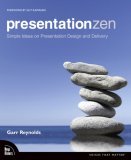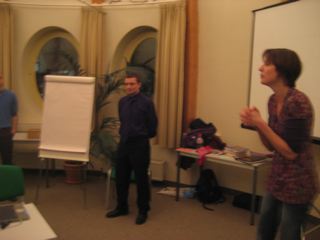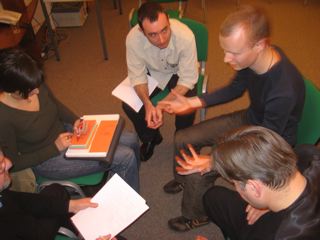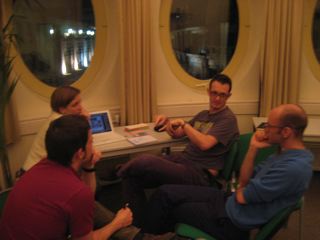How do you recognize agility?
Portia asked me this question last week. I get that question regularly. I usually give two answers.
1. Look at the values and principles
I don’t care if you write user stories. Do you really collaborate with your customer? I don’t care if you pair. Is your team learning and spreading knowledge? I don’t care how long your iterations are (as long as they’re not too long). Do you regularly provide value to your users and do you get valuable feedback? I don’t care if you have burndown charts and walls with index cards on them. Do you provide visibility and honest status updates to all involved in your project?
Ask a few questions about values and principles. Ask about the status of the project. Look at the way the team behaves. Ask “Why?”. “Because the book/guru says so” is not an acceptable answer. Look for a systems thinking answer.
It’s so easy to spot the fakes.
It’s easy to see if there is fun, passion, honesty, openness, enthusiasm and a desire to do things that M-A-T-T-E-R.
But Portia knows that already.
2. Why do you care?
What’s so interesting about ‘being agile’? Is that a useful goal?
Some time ago, I got a call from a company to “help them to do Extreme Programming”. As a fan of XP, my reaction was “Why would you want to do that?“.
Turns out they didn’t want to do XP at all.
They wanted to have a solid demo version of their new product, ready for the industry event a few months later. They wanted to improve their software quality to decrease the time between idea and sale. They wanted more visibility into the state of the product/project, so they could make better business decisions.
Those are useful goals. Achieving those goals would be a good acceptance test for my involvement.
I’m going through these same questions with a potential new customer. They want to be agile. I keep asking why. We agree on acceptance tests that show that my involvement improves their business. Tests that show that my involvement brings them value.
Some people find it strange that I don’t emphasize (or even talk about) agile with my customers, when I start projects. Don’t get me wrong. It’s not that I hide agile: it’s on my CV (next to other stuff) and a simple google search will turn up lots of agile-related pages with my name on them. Agile works better than anything else I know of.
But, I only talk about agile after we have gotten results. It’s only XP if it succeeds. 😉
Business-IT alignment? Surely you’re joking!
I fully agree with Dave Nicolette’s assessment of the CIO concerns Top 10. There is a conflation of ends and means, similar to the one above. If these are the things that keep CIOs awake at night, I suggest they take a sleeping pill and snooze on, like they do during their workday.
Whenever someone mentions business-IT alignment I have trouble not to burst out laughing. It’s a phrase I only hear in organisations where there’s an antagonistic relationship between business and IT. “If only we could do without the other party“, they both exclaim wistfully. As one project manager said: “If only there were no customers, IT would be great!“. At which I replied: “Yeah, but unemployment benefits suck”.
In these organisations, IT people talk about “The Business”. I won’t repeat what The Business calls IT, in case young children read this blog.
On the successful projects (in those same organisations) we didn’t call them The Business.
We called them “We”.

 Last Tuesday, Stien and I hosted a
Last Tuesday, Stien and I hosted a 
